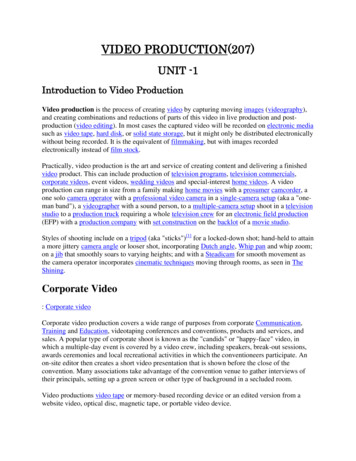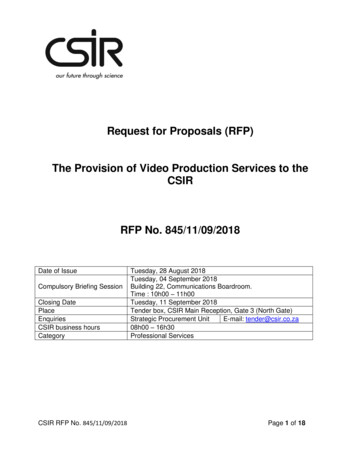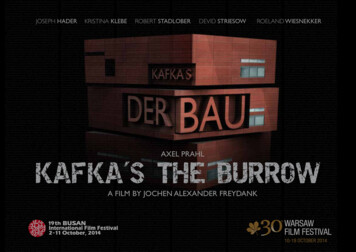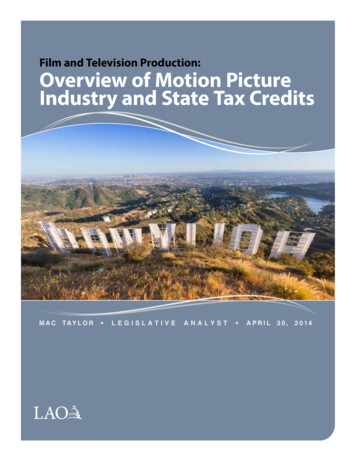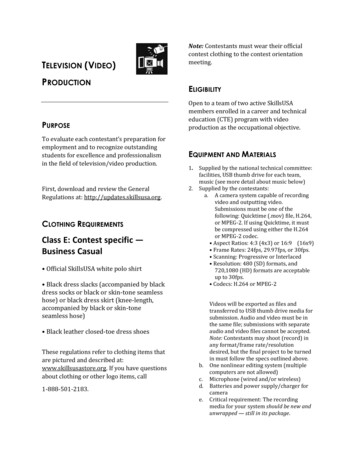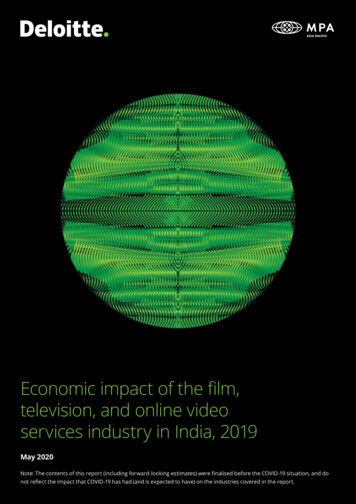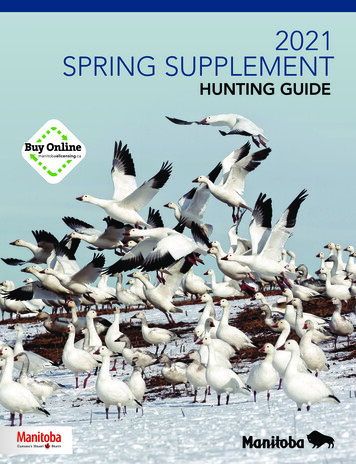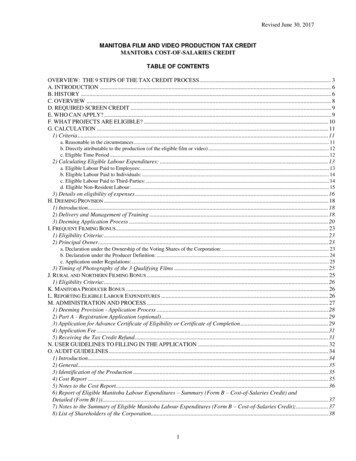
Transcription
Revised June 30, 2017MANITOBA FILM AND VIDEO PRODUCTION TAX CREDITMANITOBA COST-OF-SALARIES CREDITTABLE OF CONTENTSOVERVIEW: THE 9 STEPS OF THE TAX CREDIT PROCESS . 3A. INTRODUCTION . 6B. HISTORY . 6C. OVERVIEW . 8D. REQUIRED SCREEN CREDIT . 9E. WHO CAN APPLY? . 9F. WHAT PROJECTS ARE ELIGIBLE? . 10G. CALCULATION . 111) Criteria . 11a. Reasonable in the circumstances . 11b. Directly attributable to the production (of the eligible film or video) . 12c. Eligible Time Period . 122) Calculating Eligible Labour Expenditures: . 13a. Eligible Labour Paid to Employees:. 13b. Eligible Labour Paid to Individuals: . 14c. Eligible Labour Paid to Third-Parties: . 14d. Eligible Non-Resident Labour: . 153) Details on eligibility of expenses . 16H. DEEMING PROVISION . 181) Introduction . 182) Delivery and Management of Training . 183) Deeming Application Process . 20I. FREQUENT FILMING BONUS. 231) Eligibility Criteria: . 232) Principal Owner . 23a. Declaration under the Ownership of the Voting Shares of the Corporation: . 23b. Declaration under the Producer Definition: . 24c. Application under Regulations: . 253) Timing of Photography of the 3 Qualifying Films . 25J. RURAL AND NORTHERN FILMING BONUS . 251) Eligibility Criteria: . 26K. MANITOBA PRODUCER BONUS . 26L. REPORTING ELIGIBLE LABOUR EXPENDITURES . 26M. ADMINISTRATION AND PROCESS . 271) Deeming Provision - Application Process . 282) Part A - Registration Application (optional) . 293) Application for Advance Certificate of Eligibility or Certificate of Completion . 294) Application Fee . 315) Receiving the Tax Credit Refund . 31N. USER GUIDELINES TO FILLING IN THE APPLICATION . 32O. AUDIT GUIDELINES . 341) Introduction . 342) General. 353) Identification of the Production . 354) Cost Report . 355) Notes to the Cost Report. 366) Report of Eligible Manitoba Labour Expenditures – Summary (Form B – Cost-of-Salaries Credit) andDetailed (Form B(1)) . 377) Notes to the Summary of Eligible Manitoba Labour Expenditures (Form B – Cost-of-Salaries Credit);. 378) List of Shareholders of the Corporation. 381
Revised June 30, 2017TEMPLATE FOR AUDIT/REVIEW ENGAGEMENT REPORT. 39DEEMING DISPUTE RESOLUTION PROCESS. 40APPENDIX I: MANITOBA FILM AND VIDEO PRODUCTION TAX CREDIT LEGISLATION . 422
Revised June 30, 2017OVERVIEW: THE 9 STEPS OF THE TAX CREDIT PROCESSProject StagePre-productionThe Tax Credit Process1.Ensure that the applicant corporation, through which you willbe running Manitoba labour expenses:(a)Is a taxable Canadian corporation incorporated underthe laws of Canada or of a province of Canada;(b)Has a permanent establishment in Manitoba(production trailers/office space in MB, employee oragent in MB who can contract on behalf of thecorporation, and production equipment in MB);(c)Is producing an eligible film in the course of a film orvideo production business that is its primary business;and(d)Pays at least 25% of its “T4’able” salaries and wagesfor each fiscal year in question to “T4’able” eligibleemployees and “T4’able” employees who are eligiblenon-resident individuals, in relation to the eligible filmfor which the tax credit is claimed, for work performedin Manitoba on the eligible film (This clause refers toeligible employees appearing on the eligible applicantcorporation’s T4 summary. Payments to contractedindividuals and to corporations are not included in thiscalculation). For documentaries, the work does notneed to be performed in Manitoba. (Please seeSection N, bullet v, for more information).2.(a)(b)ProductionPrepare Request for Deeming and submit toManitoba Film & Music (MFM) (if applicable). SeeSection H for more details.Submit completed Part A Tax Credit Application toManitoba Film & Music (optional, but recommendedfor those unfamiliar with the program)) once thelocked budget is in place.3.Receive Part A Registration Certificate from MFM.4.Collect necessary Residency Declarations for each eligibleMB labour expense, as required.(a)For multi-year productions: submit application toMFM for an Advance Certificate of Eligibility after eachfiscal year that ends prior to the end of post-production.(NOTE: It is at this point that one needs to decidewhether to apply for the Cost-of-Salaries Credit or3
Revised June 30, 2017for the Cost-of-Production Credit. Once theapplication is made, the type of credit is locked in,and it is no longer possible to switch for the othercredit.) When received from MFM, file the AdvanceCertificate of Eligibility with the T2 corporate income taxreturn to the Canada Revenue Agency (CRA), alongwith Form B(1) Report of Eligible Manitoba LabourExpenditures, Form D List of Deemed Labour and anyother documentation listed on the Canada RevenueAgency Schedule 388, for each fiscal year that endsprior to the end of post production in accordance withCRA requirements.Tax credits will not be awarded on eligible nonresident labour until the production is completed –the deeming cap can only be determined based on thetotal eligible Manitoba labour across the entire show,and final deeming can only be determined once alltraining has taken place. The tax credit on eligible nonresident labour will be issued when the Certificate ofCompletion is filed with CRA.Post-production5.(a)(b)(c)DeliveryIf applicable, the Actual List of Deemed Labour (Form D,Part B) is forwarded by the eligible applicant corporationto MFM for the unions/guild/FTM to sign off that thetraining took place.Prepare costs and labour expenditures for audit orreview, if applicable.Must contact MFM for screen credit language and logoand obtain screen credit approval.6.Engage accountant (third party accountant when required), toprepare a cost report (reviewed or audited where appropriate)and a report of eligible Manitoba labour expenditures, asrequired (reviewed or audited where appropriate) – SeeCompletion Checklist and Section O for more information.7.Submit application for Certificate of Completion to MFM forreview, together with the required application fee. Theapplication must be received by MFM within 30 months ofthe end of the taxation year in which principalphotography began (unless a Waiver In Respect Of TheNormal Reassessment Period – Form T2029 - has been filedwith the Canada Revenue Agency, in which case the deadlineis increased to 48 months after the end of the fiscal year inwhich principal photography began). Please note that oncean Advance Application or a Completion Application hasbeen made, the type of credit (Cost-of-Salaries or Cost-of-4
Revised June 30, 2017Production) is locked in and can no longer be changed forthe other credit. For multi-year productions, a CompletionApplication is required regardless of whether or not an AdvanceCertificate of Eligibility was previously issued.8.Receive Certificate of Completion from MFM.9.Submit complete audit package to the Canada RevenueAgency, including the Certificate of Completion, along with theannual corporate income tax return (T2). CRA will make thefinal determination of the value of the credit amount and willissue the cheque to the eligible applicant corporation.5
Revised June 30, 2017MANITOBA FILM AND VIDEO PRODUCTION TAX CREDITGUIDELINESManitoba Cost-of-Salaries CreditThis document is a general guide and may not be relied upon in order to determine eligibility or the amount ofan anticipated credit. Please consult the Manitoba Film and Video Production Tax Credit legislation. Pleasenote that a careful review of the legislation and regulations is recommended before you apply for the credit.A. INTRODUCTIONThe Legislation for the Manitoba Film and Video Production Tax Credit is found insections 7.5 to 7.9 of The Income Tax Act (Manitoba); a copy is attached to thisdocument as Appendix I for convenience purposes only. Where there is a conflictbetween the information contained in this package and the authoritative text of thelegislation set out in the official volumes, the latter shall prevail.Who do I contact for help with the program?If you have any questions or need help in completing the application, please do nothesitate to call Manitoba Film & Music (MFM) for assistance. MFM will providepublished documentation and general information on eligibility and calculationrequirements.Brian Clasper, Tax Credit AnalystManitoba Film & Music410 – 93 Lombard AvenueWinnipeg, MB R3B 3B1Email: brian@mbfilmmusic.caTelephone: (204) 947-2040 ext. 25Fax: (204) 956-5261Web: www.mbfilmmusic.caB. HISTORYThe Manitoba Cost-of-Salaries Credit was introduced in the spring of 1997 to providean incentive to the private film and television production industry to create economicdevelopment growth in the province. This refundable tax credit is calculated based on a6
Revised June 30, 2017production’s eligible Manitoba labour expenditures and eligible non-resident labour.Producers may use it to leverage financing for production budgets through interimfinancing agreements with banks or other financial organizations.In 1998 the Tax Credit was amended to include a Deeming Provision in order todevelop a better-trained workforce (See Section H for more information).The 2004 Manitoba Budget extended the program until March 1, 2008, introduced a 5%Frequent Filming Bonus and a 5% Rural Filming Bonus, and removed the restriction onapplicants holding CRTC licenses.The 2005 Manitoba Budget increased the base rate to 45%. The Budget also reducedthe Rural Bonus limit to 35 km (22 miles) from the center of Winnipeg and introducedthe following treatment for series under the Frequent Filming Bonus: 2 hours of airtimeequals 1 frequent filming credit.As of April 1, 2007, the Canada Revenue Agency (CRA) is co-administering theManitoba Film and Video Production Tax Credit with Manitoba Film & Music on behalfof the Province of Manitoba. As a result of this administration change, the Manitobacredit will be more closely aligned with federal/CRA tax credit interpretations. Multi-yearproductions are able to apply for and receive their tax credit after each fiscal year,based on an Advance Certificate of Eligibility. Please see Section M for the list ofresponsibilities of each organization.The 2007 Manitoba Budget extended the program until March 1, 2011.The 2008 Manitoba Budget increased the Frequent Filming Bonus to 10%, introducedthe 5% Manitoba Producer Bonus, increased the deeming cap to 30%, and eliminatedthe “supervision” requirement of the Deeming Provision.The 2010 Manitoba Budget introduced the 30% Cost-of-Production Credit calculated onEligible Manitoba Production Expenditures, including Manitoba labour and eligible nonresident labour, and extended the program until March 1, 2014.NOTE: Productions have the option of choosing either the Manitoba Cost-of-SalariesCredit or the Manitoba Cost-of-Production Credit, whichever is the most beneficial forthe production. The final, irreversible selection is made when an application is madewith Manitoba Film & Music for an Advance Certificate of Eligibility or for a CompletionCertificate. For guidelines relating to the Manitoba Cost-of-Production Credit, pleasesee the Manitoba Film & Music website.The 2013 Manitoba Budget extended the program until December 31, 2016.The 2015 Manitoba Budget extended the program until December 31, 20197
Revised June 30, 2017Principal Photography StartAfter January 1, 1997After March 6, 1998After April 19, 2004After March 8, 2005After April 1, 2007After December 31, 2007After March 31, 2010After April 17, 2012After April 1, 2017Tax Credit Calculation35% tax credit on Manitoba labour.35% tax credit on Manitoba labour & eligible non-resident labour.35% tax credit on Manitoba labour & eligible non-resident labour with5% frequent filming and 5% rural bonuses available45% tax credit on Manitoba & eligible non-resident labour with 5%frequent filming and 5% rural bonuses available.Allow multi-year productions to receive tax credits prior to year ofcompletion based on an Advance Certificate of Eligibility.45% tax credit on Manitoba & eligible non-resident labour with 10%frequent filming, 5% rural bonus, and 5% Manitoba producer bonus.Deeming cap increased to 30% with 2 Manitoba Trainees requiredper eligible non-resident.Option of applying for the 30% Cost-of-Production Credit on EligibleManitoba Expenditures, including MB labour and eligible non-residentlabour.Accommodation costs incurred and paid up to 300 per night perunit, inclusive of taxes, can be claimed as eligible accommodationexpenditures when calculating the Cost-of-Production Credit.An Application Fee is required with a Completion Application forproductions where principal photography begins after August 31,2017.C. OVERVIEWThe Manitoba Film and Video Production Tax Credit is a refundable corporate incometax credit. It is available to qualifying producers of eligible Manitoba productions andco-productions. The tax credit is provided to the same extent for all taxpayers,regardless of their income level and marginal tax rate.The Manitoba Tax Credit is compatible with the Canadian Film or Video Production TaxCredit (CPTC) and the Film or Video Production Services Tax Credit (PSTC), which areco-administered by the Canadian Audio-Visual Certification Office (CAVCO) and CRA.The Cost-of-Salaries Credit provides production companies with a 45% tax credit basedon eligible Manitoba labour expenditures and eligible non-resident labour. The eligibleapplicant corporation may qualify for a 50%, 55%, 60%, or 65% tax credit depending onits eligibility for some or all of the bonuses (see Sections G, I, J, and K).The tax credit includes a “Deeming Provision,” whereby if a technical position is unableto be filled by a willing, available, and/or qualified Manitoba resident, the salary of aqualifying non-resident may be deemed eligible for the tax credit provided that there isat least one Manitoba Trainee on the production for every eligible non-resident beingdeemed (See Section H for more information, including caps).The Manitoba Film and Video Production Tax Credit requires the payment of anApplication Fee (see Section M, Number 4 for information on the Application Fee).8
Revised June 30, 2017There are no corporate caps regarding the number of applications or the amountof tax credit that a corporation may apply for.There are no Canadian broadcast requirements.There are no minimum or maximum Manitoba production spend requirements.There are no copyright ownership requirements.There are no Manitoban or Canadian content requirements.Non-Manitoba share ownership of the eligible applicant corporation does notaffect the ability to claim the credit.D. REQUIRED SCREEN CREDITEligible applicant corporations must contact the Tax Credit Analyst at Manitoba Film &Music in order to receive the correct logo for inclusion in the production’s screen credits(and billing block, if applicable) and detailed placement requirements.Brian ClasperTax Credit AnalystEmail: brian@mbfilmmusic.caPhone: (204) 947-2040 ext.25E. WHO CAN APPLY?An eligible applicant corporation must:a) be a taxable Canadian corporation, incorporated under the laws of Canada or aprovince of Canada;b) have a permanent establishment in Manitoba;c) be producing an eligible film in the course of a film or video production businessthat is its primary business; andd) pay at least 25% of its “T4’able” salaries and wages for each fiscal year of theproduction to “T4’able” eligible employees and “T4’able” eligible non-residentindividuals, in relation to the eligible film for which the tax credit is claimed, for9
Revised June 30, 2017work performed in Manitoba on the eligible film, except for documentaries wherethe work can be performed anywhere (Please see Section N, bullet v, for moreinformation).For reference, the income tax act defines “permanent establishment” with three criteria.A production can satisfy the requirements by having production trailers/office space onsite (“fixed place of business”), having producers on site (“employee or agentestablished in a particular place with a general authority to contract on behalf of thecorporation”), and having production equipment on site (“uses substantial machinery orequipment in a particular place in a province”).Co-Productions and/or Co-Ventures are eligible. The Manitoba Film and VideoProduction Tax Credit is designed to encourage outside collaboration with nonManitoba producers.F. WHAT PROJECTS ARE ELIGIBLE?Eligible projects include fully financed scripted and documentary series, feature films,feature-length documentaries, television movies, documentary one-offs, variety,animation, children’s programming, music programming, and informational series.These productions can be released on media used for traditional film and videoproductions, as well as multimedia and digital. For a list of INELIGIBLE productions,please see section 7.7(1)(c) of the tax credit legislation available at the end of thisinformation package as Appendix I.Special effects work on eligible film and video projects as listed above is eligible underthe Manitoba Film and Video Production Tax Credit.Filming outside of the province of Manitoba is allowable within the spirit and intent ofthe Act, recognizing that certain productions require shooting outside of Manitoba.However, 25% of the “T4’able” salaries and wages of the eligible applicant corporationfor each fiscal year in question must be paid to “T4’able” eligible employees and“T4’able” employees who are eligible non-resident individuals, in relation to the eligiblefilm for which the tax credit is claimed, for work performed in Manitoba on the eligiblefilm. For documentaries, the work does not have to be performed in Manitoba (Pleasesee Section N, bullet v, for more information).Interactive digital media projects, including video games, do not qualify under theManitoba Film and Video Production Tax Credit. Convergent and interactive digitalmedia projects may be eligible under the Manitoba Interactive Digital Media Tax Creditprogram administered by Manitoba Growth, Enterprise and Trade. For informationregarding this program, please contact:Manitoba Growth, Enterprise and TradeMs. Avery JodoinBusiness Development Manager – Interactive Digital Media10
Revised June 30, 20171010 – 259 Portage AvenueWinnipeg, Manitoba CANADAR3B 3P4Phone: (204) 945-0975Email: dev/sibd/idm taxcredit.htmlG. CALCULATIONThe Cost-of-Salaries Credit provides eligible applicant corporations with a 45% base taxcredit calculated on eligible Manitoba labour expenditures and eligible non-residentlabour. The eligible applicant corporation may qualify for a 50%, 55%, 60%, or 65% taxcredit depending on if it qualifies for some or all of the bonuses. These include theFrequent Filming Bonus (5% before January 1, 2008, 10% thereafter), the ManitobaProducer Bonus (5%), and the Rural Bonus (5%).The appropriate rate will be applied to the eligible Manitoba labour expenditures andeligible non-resident labour after deduction of any deferrals and any governmentassistance received by the eligible applicant corporation.Government assistance is defined as the amount of assistance which thecorporation receives or is entitled to receive from a government, municipality orother public authority whether as a grant, subsidy, forgivable loan, deductionfrom tax, investment allowance or any other form of assistance, other than:(a) any film and video production tax credit under this Act or under the federalAct;(b) government amount paid or payable to the corporation by The CanadaMedia Fund, Telefilm Canada or Manitoba Film and Sound RecordingDevelopment Corporation that is recoupable or repaid;(c) any amount received or receivable under The Canada Media Fund LicenceFee Program;(d) the amount of a credit under section 10.1 (paid work experience tax credit);and(e) any other amount prescribed by regulation.1) CriteriaLabour expenses must satisfy the following three criteria in order to be eligiblea. Reasonable in the circumstances11
Revised June 30, 2017The dollar value of the labour expense must conform to industry standards, andthe type of the labour expense must be generally recognized as being essentialto the production of the film. If the amount is unreasonable, only the excessiveamount is disallowed. This is a general description.b. Directly attributable to the production (of the eligible film or video)The production of the film must be the immediate cause of the labour expense.For claims received by the CRA after April 1, 2007, CRA's application policy FIS2006-01, Application of the phrase "directly attributable" that is found in thedefinition of "labour expenditure" in subsection 125.4(1) of the Income Tax Actand in the definition of "Canadian labour expenditure" in subsection 125.5(1) ofthe Act, available at plcs/p2006-01-eng.html will apply.c. Eligible Time Periodi)Taxation/Fiscal Yeara.b.Labour expenditures must be incurred and paid after 1996 andbefore January 1, 2020; and,Labour expenditures must be incurred and paid within 60 days ofthe end of the taxation year(s) of the production.Amounts incurred in the eligible applicant corporation’s taxation year butpaid more than 60 days following the end of the taxation year, may not beclaimed in the taxation year. However, such amounts may be claimed inthe subsequent taxation year of the corporation if they are paid in thesubsequent taxation year or within 60 days following the end of thesubsequent year.ii)Stages of ProductionLabour expenditures must be incurred from the “Commencement ofProduction” to the end of post-production (delivery date) to be eligible.“Commencement of Production” - To reduce uncertainties ininterpretation, the commencement time for a production will be defined toallow the possibility for eligible costs to be incurred as early as two yearsbefore principal photography begins. Eligible labour expenditures willinclude those incurred after principal photography begins, plus thoseincurred after the latest of the following three times:1. The time at which the eligible applicant corporation or its parentcompany first incurs development labour costs for the development12
Revised June 30, 2017of property of the corporation that is script material on which theproduction is based;2. The first time at which the eligible applicant corporation or itsparent company acquires a right in respect of the story that is thebasis of the final script. Such rights might include a publishedliterary work, play, or screenplay;3. Two years prior to the date on which principal photography begins.It is intended that in-house development labour costs for an initial draft ofa script, as well as the cost of modifications, should be eligible. These inhouse costs could include the cost to hire an independent writer to createa script on the basis of some other story or literary work for which thecorporation has acquired the rights.Existing conditions on eligible labour expenditures will also apply toscriptwriting labour (e.g. the exclusion of amounts determined byreference to profits or revenues). However, the cost to acquire an initialscrip
Manitoba Film & Music (MFM) (if applicable). See Section H for more details. (b) Submit completed Part A Tax Credit Application to Manitoba Film & Music (optional, but recommended for those unfamiliar with the program)) once the locked budget is in place. 3. Receive Part A Registration Certificate from MFM. Production 4.
